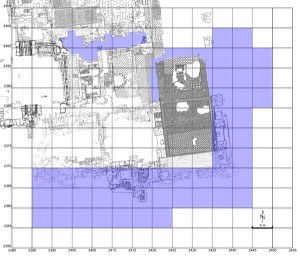In 2009, remains of a first century AD bath building were identified within the much larger second century AD bathing complex of Sagalassos. The remains consisted of the original North outer wall, incorporated in the later service area, and traces of possibly two semi-circular niches forming the original South side of the first century building. One of the niches was partially incorporated as a private bath in the later larger bath building.
The first aim of the 2010 excavation campaign of the Roman Baths is to enhance our understanding of its original building phase, by completing the excavation of the passage-way which was cut through the original northern outer wall, possibly in early Byzantine times, in order to connect the modified service area and the new service area which was installed in the former Caldarium 2 area at that time. The excavation of this area will provide both stratigraphical and structural criteria, sustaining the interpretation of the relative chronological sequence of the bathing complex. With the same aim in mind, it is our intention to continue the excavation along the actual south wall of the bath building, in order to trace the presumed presence of other semi-circular niches of the original building phase, and sustain both our reconstruction of the original building phase, as well as the sequencing of the building phases through time.
The second aim of the 2010 excavation campaign of the Roman baths concerns the excavation along the actual East outer wall of the complex, on its outer side, mainly focusing on the area of the SE pier of Frigidarium 1, in order to establish the presumed presence of the east arm of the mentioned frigidarium, in parallel to its already excavated West arm. The excavations will be limited to the outside of the building and will focus on studying the stratigraphical and structural build-up of this part of the imperial bath complex. If there is an eastern arm some excavation inside part of it will take place. At the same time the northeast niche of the southern apodyterium may also be further excavated in order to find potential remains of the statue of Faustina Minor, who once may have stood there.

Figure 1: Plan of the upper level of the Roman Baths with the location of the zones within which excavations will take place.
For more, see www.sagalassos.be/en/webreports/2010.

